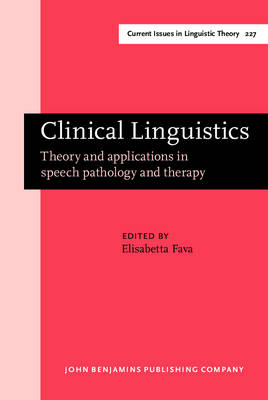
Clinical Linguistics
John Benjamins Publishing Co (Verlag)
978-90-272-4735-3 (ISBN)
This book covers different aspects of speech and language pathology and it offers a fairly comprehensive overview of the complexity and the emerging importance of the field, by identifying and re-examining, from different perspectives, a number of standard assumptions in clinical linguistics and in cognitive sciences. The papers encompass different issues in phonetics, phonology, syntax, semantics, and pragmatics, discussed with respect to deafness, stuttering, child acquisition and impairments, SLI, William’s Syndrome deficit, fluent aphasia and agrammatism. The interdisciplinary complexity of the language/cognition interface is also explored by focusing on empirical data from different languages: Bantu, Catalan, Dutch, English, German, Greek, Hebrew, Italian, Japanese, and Spanish.
The aim of this volume is to stress the growing importance of the theoretical and methodological linguistic tools developed in this area; to bring under scrutiny assumptions taken for granted in recent analyses, which may not be so obvious as they may seem; to investigate how even apparently minimal choices in the description of phenomena may affect the form and complexity of the language/cognition interface.
1. Acknowledgments; 2. Editor's Introduction (by Fava, Elisabetta); 3. I. Phonology in clinical applications; 4. Phonology as human behavior: Theoretical implications and cognitive and clinical applications (by Tobin, Yishai); 5. Segmental vs syllable markedness: Deletion errors in the paraphasias of fluent and non-fluent aphasics (by Ouden, Dirk-Bart den); 6. II. Words in deafness and stuttering; 7. Morphosyntactic fragility in the spoken and written Italian of the deaf (by Ajello, Roberto); 8. The EXPLAN theory of fluency control applied to the diagnosis of stuttering (by Howell, Peter); 9. The EXPLAN theory of fluency control applied to the treatment of stuttering (by Howell, Peter); 10. III. Morphology and syntax in child language disorders; 11. Verb Movement and finiteness in language impairment and language development (by Bastiaanse, Roelien); 12. A-bar movement constructions in Greek children with SLI: Evidence for deficits in the syntactic component of language (by Stavrakaki, Stavroula); 13. Morphological accessibility in Zulu (by Suzman, Susan M.); 14. Language production in Japanese preschoolers with specific language impairment: Testing theories (by Tanaka Welty, Yumiko); 15. IV. Issues on grammar and cognition; 16. Testing linguistic concepts: Are we testing semantics, syntax or pragmatics? (by Paltiel-Gedalyovich, Leah R.); 17. SLI and modularity: Linguistic and non-linguistic explanations (by Rybarova, Dusana); 18. The language/cognition interface: Lessons from SLI and Williams Syndrome (by Stojanovik, Vesna); 19. V. Grammatical structure in aphasia; 20. Grammar and fluent aphasia (by Edwards, Susan); 21. Failure to agree in agrammatism (by Gavarro, Anna); 22. The Verb and Sentence test: Assessing verb and sentence comprehension and production in aphasia (by Rispens, Judith); 23. Case assignment as an explanation for determiner omission in German agrammatic speech (by Ruigendijk, Esther); 24. The role of verbal morphology in aphasia during lexical access: Evidence from Greek (by Tsapkini, Kyrana); 25. Index of Subjects; 26. List of Contributors
| Erscheint lt. Verlag | 18.7.2002 |
|---|---|
| Reihe/Serie | Current Issues in Linguistic Theory ; 227 |
| Verlagsort | Amsterdam |
| Sprache | englisch |
| Maße | 164 x 245 mm |
| Gewicht | 620 g |
| Themenwelt | Geisteswissenschaften ► Sprach- / Literaturwissenschaft ► Sprachwissenschaft |
| Medizin / Pharmazie ► Gesundheitsfachberufe ► Logopädie | |
| ISBN-10 | 90-272-4735-8 / 9027247358 |
| ISBN-13 | 978-90-272-4735-3 / 9789027247353 |
| Zustand | Neuware |
| Haben Sie eine Frage zum Produkt? |
aus dem Bereich


